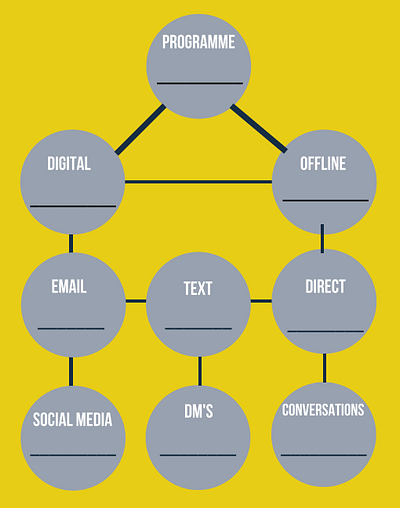Do you know which marketing tactics are working for your organisation?
In this article, we’ll explain key marketing principles and show you how to outline a plan. This will help you spend your marketing budget more strategically – and get a higher return on your investment.
Why are my marketing efforts not working?
If you feel your marketing isn’t driving the results you want, it’s often because of the following:
- You’re not speaking to the right people
- You’re not talking about benefits
- The return on investment (also referred to as ROI) is not being tracked
- Your message isn’t consistent, or it’s repetitive
- Your campaign didn’t start early enough
Putting together a marketing plan can help avoid the above as it brings all your marketing tactics together in one place, so you see what you’re planning to say and where.
Best practice – the hybrid model: digital and offline
The image below shows what your marketing plan might look like. At the top, you’ve got your new programme or campaign – for example, an event you’re planning – followed by ‘Digital’ and ‘Offline’. Beneath these are the different marketing activities (these can be changed depending on what marketing channels you have set up).

The key is to hit your marketing from all angles and make sure it’s diversified. This is why, when you have something new to talk about, you should market both online and offline – if something happens and you can’t reach people digitally, you can still speak to them offline. This approach also allows you to make changes when you see something isn’t giving you a return. You can figure out what’s not working and try something else instead.
The ‘secret sauce’
If you don’t have lots of money to spend on marketing, you can still market effectively. The secret is to plan ahead, be consistent and give it time – at least 90 days. Judge your success after a few repetitions of this cycle and you’ll see what is or isn’t working.
Or, to put it another way:
Planning + consistency + time = success
Digital marketing examples
Although people perhaps don’t read emails as much as they used to, that doesn’t mean you should disregard email marketing completely. You just need to use it in a different way to how it was used a few years ago. Here are some things to bear in mind:
- Use lists and tags to organise your current and future customer groups – you’re going to speak to them differently
- Use email templates to save time
- Plan your marketing emails at least four weeks in advance
- Keep your emails and newsletters succinct and to the point
- Replace text with video where possible
Organic social media (without ads)
People often assume that social media doesn’t get you a return on investment unless you pay for ads. But this simply isn’t true. Ads can work, but you don’t always have to spend money to connect with your audience. There are many different organic strategies to try out:
- Know where your “lifers” are – where are the people who are going to be your most dedicated customers / members?
- Post updates and engage with your audience regularly
- Ramp up content around the launch of a new season, programmes, classes, courses or events
- Partner with influencers for giveaways and challenges
- Use Stories (these are more effective on Instagram than Facebook) to bring your message to life
- Use Facebook Groups to build relationships and grow your member / customer base (we don’t mean a group for your existing members, but rather a group of people who are your target audience) – see our LoveAdmin Facebook Groups for examples
Offline marketing examples
Direct methods
These are more traditional marketing tactics before people relied on digital. There are still people who don’t spend a lot of time on Facebook or read emails, so you need to use word of mouth, and printed items and collateral. Here are some examples:
- Direct mail – posting marketing materials through letterboxes
- Handouts at the end of training sessions / real life events
- QR codes on keyrings, stickers or marketing collateral in any member-facing areas of your clubhouse / business
Conversations
Verbal marketing and referrals are an overlooked goldmine, but they’re not always the most reliable marketing tactics. Therefore, they shouldn’t be the only way you obtain new members. Here are a few methods to try:
- Systematic list and track – assign people in your organisation to talk to customers and have them track conversations to make them accountable
- Confidence in conversations e.g. after an event, speak to attendees before they leave. Hand them a voucher, but couple it with a conversation to add that personal touch. This is the magic touch that turns marketing into relationship building
Hybrid methods
This is almost an evolution of modern-day marketing. It’s not all online (such as email and social media), but it’s not like traditional offline methods either – it falls somewhere in the middle.
Text messaging
A great substitute for any lack of email effectiveness is text messaging. In the past, there has been pushback about using text because it feels invasive on members’ time, but there is a huge convenience factor as some people prefer texts over emails.
- Opt-in collection – get their permission to text them
- Send important reminders only
- Offer links to free content to give the recipient a reason to open your messages
- Don’t just sell all the time – observe the 80/20 rule for your messages (80% provides value, 20% is selling)
Direct message (DM) campaigns
A direct message – or DM – campaign is through Facebook or Instagram. The purpose is not to sell but to build a relationship through conversations.
Think of people as if they are standing in front of you in real life. Open up and be friendly – then if they want to sign up to your organisation, you are top of their mind.
Our tips for a successful DM campaign are:
- Don’t be intimidating. Instead, show gratitude and be as helpful as possible. For example, say something like: “Thank you for your support. If you have any questions about our organisation, please let us know.”
- Track conversations – find people in your Facebook Group or those who have liked your social media accounts and add them a spreadsheet to track the conversations you have with them
- WordPress website add-on – if your website is build on the WordPress platform, replace website chat boxes with Facebook Messenger, so messages come directly to your Facebook
With all these tactics, make sure you are compliant with GDPR and data privacy rules.
Useful technology to carry out a DIY marketing campaign
- Google Sheets – unlike Excel, multiple people can share and work on the same spreadsheet at the same time. Sheets is also great for tracking data
- HubSpot/Hootsuite – plan out strategic social media posts in advance and build out nice visuals
- LoveAdmin V2 – set up auto-drip emails, group people into lists, send SMS messages
- Canva/Adobe Spark – great for graphic design imagery across social media, printed material, email, and worksheets
Final tip: The success of your marketing all comes down to tracking
If you don’t track your results, you don’t know what’s working and what to change. And if you continue the same marketing activities without seeing results, you’re never getting a return on your investment.
Whatever tactics you decide to use, you have to repeat them to get a large data pool to judge. Only then will you know what’s bringing in leads and members.
What marketing activities have you been running up until now? How effective have they been? If they’ve not been working successfully up to this point, try out some of the methods we’ve shared in this article.
If you’re involved with a gymnastics or football club and would like to find more content like this, join our dedicated Facebook Communities:
















